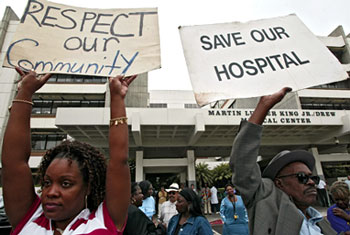
NEW YORK (FinalCall.com) – The Mayor’s Commission for Economic Opportunity has stated that 50 percent of the children born in New York City are born in poverty. This translates into over 300,000 children in the city not having health insurance. New York City’s billionaire mayor, Michael Bloomberg, says the local government must provide health insurance for those children who are uninsured.
“We need to look at things like enrolling children in health insurance at the time they’re born and enrolling parents,” writes Donna Lawrence, executive director of the Children’s Defense Fund-NY, in an article that appeared in the Gotham Gazette on Sept. 25.
Addressing the mayor’s commissioned report on poverty, Ms. Lawrence stated: “As a blueprint, it’s great. The fact that the mayor has done this and is taking leadership is a good signal.”
However, Ms. Lawrence’s lament was that the mayor did not go into any detail on how he will get the uninsured children insured.
New York City is not the only locality struggling with this issue and politicians are not the only ones dealing with the issue of the uninsured. But, according to the National Conference of State Legislatures, in recent years states have stepped in, passing incremental reforms trying to fill the coverage gaps.
“Much of what passes for wisdom about the uninsured in policy circles is not founded on strong theory, writes Catherine McLaughlin in the book “Health Policy and the Uninsured.” She noted the tension between academics and policymakers.
“Social scientists will always look for better answers, whereas policymakers want the best available answers. Social scientists can wait; policymakers cannot.”
Nationally, the poverty rate for children under age 18 in 2005 (17.6 percent) remained higher than that of 18 to 64-year-olds (11.1 percent) and that of people 65 and older (10.1 percent), according to a U.S. Census Bureau report that was issued in August.
The report also shows that the number of uninsured children increased nationally between 2004 and 2005, from 10.8 percent to 11.2 percent (7.9 million to 8.3 million respectively). Black children comprise an estimated 12.5 percent of those not insured nationally.
“With an uninsured rate at 19.0 percent in 2005, children in poverty were more likely to be uninsured than all children,” the census report stated.
The U.S. Office of Management and Budget, using the Consumer Price Index, states that the average poverty threshold for a family of four in 2005 was $19,971; for a family of three, $15,577; for a family of two, $12,755.
In the Census Bureau’s “Income, Poverty and Health Insurance Coverage in the United States: 2005” report, real median income rose in the U.S. by 1.1 percent between 2004 and 2005 at $46,326. Black households had the lowest median income in 2005 ($30,858). Asians had the highest median income ($61,094); White households at $50,784, with Latino households at $35,967. The three-year average for Native Americans and Alaska Native households was $35,967, according to the current Census Population Survey (CPS).
The percentage of people without health insurance coverage rose from 15.6 percent to 15.9 percent (46.6 million people). Blacks comprised 19.6 percent (7.2 million) of those uninsured. For Latinos, the numbers increased from 2004 to 2005, from 13.5 million to 14.1 million (or 32.7 percent). Whites who are uninsured remained statistically unchanged from 2004 to 2005 at 11.3 percent, or 22.1 million. For Asians during that same period, the uninsured rate increased to 2.3 million, up from two million, or a percentage increase from 16.5 percent to 17.9 percent. The three-year average for Native Americans and Alaska Natives without health insurance was 29.9 percent.
“The health care safety net–that is, state and federal government-sponsored programs intended to “catch” people unable to access services in the private market–is being increasingly strained,” according to the National Conference of State Legislatures.
In 2006, Massachusetts and Vermont passed legislation to ensure that all state residents have health insurance; Chapter 58 of the Acts of 2006 promises that every person in the Commonwealth will have health care access by 2009.
While the legislative trend in the states is to fill the gaps public and private systems leave behind, some states are still considering a single-payer, universal health insurance system that would cover every citizen within their borders. San Francisco passed the Health Access Plan, which is aimed at covering 82,000 city residents. So far in 2006, eight states have been considering universal health care bills. Seven states have commissioned studies to look at the possibility of such a system.
“Every state wrestles with the impact that rising healthcare costs and numbers of uninsured have on the economy and budget,” writes Nina Owcharenko, senior policy analyst for the Heritage Foundation’s Health Care division and Robert Moffit, Ph.D., director of the Center for Health also at the Heritage Foundation.
“Nonetheless, every state has its own healthcare delivery system that operates in a unique political, cultural, legal and regulatory climate. The process illustrates that states, regardless of their differing characteristics, can tackle the difficult healthcare issues,” they conclude, “that thus far have stymied federal policymakers.”












